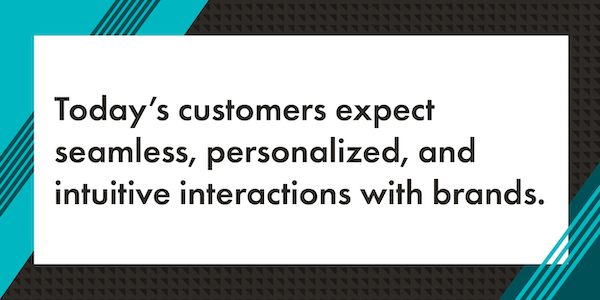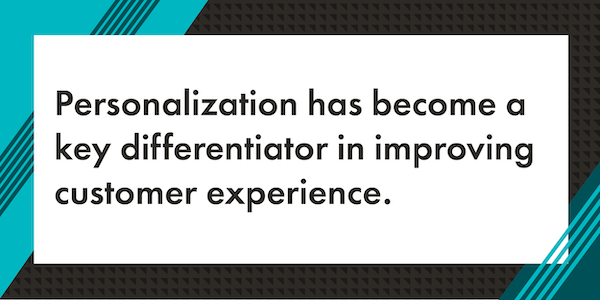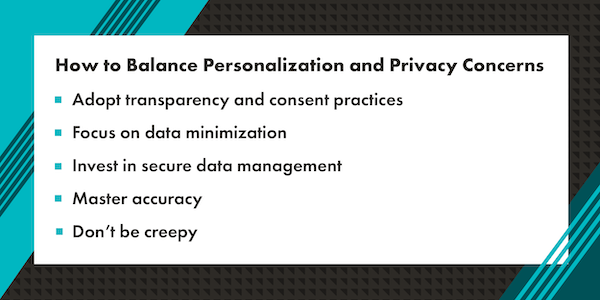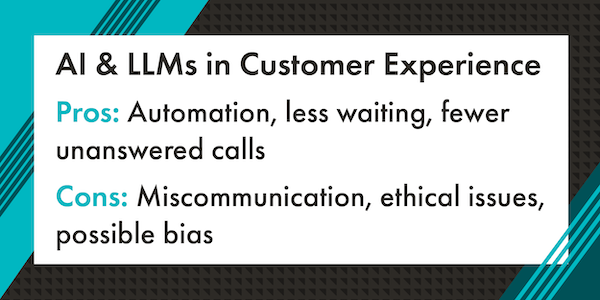
06/12/2025 by Russ Felker
Improving Customer Experience with Technology
At a recent discussion panel, conversations with peers had me thinking about technology’s role in improving customer experience. More business impact than ever before is driven by technology. The landscape of customer experience is no exception.

Today’s customers expect seamless, personalized, and intuitive interactions with brands. A crucial role in meeting these demands is held by technology leaders, such as myself. From AI chatbots to advanced self-service tools, businesses look to technology to improve efficiency and create more meaningful customer experiences.
Yet, as technology improves customer experience, it also presents new challenges. How do you get closer to what customers want without crossing the line?
Balancing Personalization vs Privacy
One of the biggest challenges organizations face today is finding the balance between personalization and privacy concerns. While we all love when a company “gets us”, however, data collection can make people feel uneasy.

Customers expect companies to understand their preferences AND deliver relevant, timely service. Personalization has become a key differentiator in improving customer experience, leading to higher satisfaction, loyalty, and conversion.
However, personalization relies heavily on accurate data collection. Companies must gather and analyze vast amounts of data to create tailored experiences both from internal sources and third-party data sources. This raises questions and brings privacy and cybersecurity concerns to the forefront. No one wants to be the company responsible for leaking your information.
To navigate these challenges, organizations need to:
Adopt Transparency and Consent Practices
Customers need to trust that their data is being handled responsibly. Transparency builds trust so share how their data gets collected, stored, and used. Giving customers control through clear consent processes can foster better relationships.
Focus on Data Minimization
Only collect the data that’s necessary for improving customer experience. This helps customers feel more at ease and comfortable engaging with the brand. As a bonus, it also helps limit exposure to potential breaches.
Invest in Secure Data Management
Robust data encryption, secure access controls, and regular audits are critical to protect against data breaches.
Master Accuracy
Companies must use more resources around the validation of the data collected. Delivering information and analysis is great, but only if the backing data is accurate.
Don’t Be Creepy
Collecting information is extremely helpful in improving customer experience through personalization. However, it’s important to train the people (and manage the scripts of AI) that leverage this information. There’s a fine line between coming across as knowing the person and them thinking you have a webcam in their house.
Striking the right balance between privacy and personalization requires organizations to align in their customer experience strategies. Regulatory frameworks and ethical data practices are essential.

Improving Customer Experience With Self-Service Tools
As improving customer experience becomes critical for organizations, there’s an increasing push to empower business users.
Not long ago, even small customer-facing changes needed collaboration with IT or development teams. This caused bottlenecks, slowing down innovation and responsiveness.
Today, customer experience management is accessible to everyone with the rise of self-service tools.
One of the most significant trends is the adoption of no- and low-code platforms. Business users can now build, customize, and deploy customer experience solutions. This includes creating workflows for customer support, automating routine tasks, and personalizing customer journeys.
Now, even non-technical teams can take a more direct and hands-on approach.
Key benefits of these tools include:
Faster Iteration
Business users can quickly adapt to customer feedback, market changes, or business needs without waiting for developer intervention. This allows for more agile and responsive customer experience management.
Less IT Dependence
With customer experience teams able to design and manage their own solutions, there’s less strain on IT departments. They’ll instead be able to focus on more complex, strategic projects.
Personalization at Scale
Internal teams can rapidly experiment with and launch new strategies. They can try segment-specific messaging or targeted promotions, without having to navigate lengthy timelines.

These tools empower business users, reduces dependence on technical teams, and accelerates innovation. Customer experience teams become better at adapting to changing customer needs and driving more personalized, data-driven experiences. While efficiency improves, organizations can also stay ahead in an increasingly competitive market.
But (there’s always a “but”, right?) these tools must be deployed with care, ensuring privacy, ethics, and security are baked in.
Guardrails and guidelines need to be established at the organizational level. They need to ensure only proper data is delivered to the intended recipients and that only approved methods of delivery are leveraged. Monitoring must also be in place so both the whole of the technology landscape is accounted for in security initiatives, scans, and that resilience of the solutions are maintained.
AI and Large Language Models in Customer Experience
One of the most transformative impacts in recent years is the availability of AI models like Large Language Models (LLMs). These systems can understand and generate human-like text and voice. Businesses can automate a variety of customer interactions with AI — from chatbots to virtual assistants.
LLMs have had a profound impact on customer experience in multiple industries:
Healthcare
AI-driven chatbots and virtual assistants can provide medical transcription, appointment management, and even symptom checking. It helps reduce the workload for all kinds of healthcare professionals – including my vet.
Banking
In the financial industry, AI-powered assistants help customers with account queries, transaction monitoring, and fraud detection. By offering faster, more accurate responses, these systems greatly improve customer experience. Except of course when they don’t. I recently got blocked from a cash withdrawal at an ATM about a mile from my house at a gas station I use quite often.
Travel and Hospitality
LLMs are also transforming the travel industry by helping customers book flights, hotels, and manage itineraries through highly personalized and conversational interfaces. But beware of the data being used. Getting routed to an attraction that’s closed that day, but didn’t update their website, can be quite annoying (cut to Woody Harrelson and Matthew McConaughey commercial for AI.)

One major benefit? Less waiting and fewer unanswered calls. A close second? Reps having to repeat answers to previously asked, and answered, questions.
Personally, long hold times and calls going unanswered (including being sent to voice mail) are some of the more annoying parts of working with businesses. A system that always answers, even if it can’t meet every inquiry, is a major step to reducing friction – usually me rubbing the bridge of my nose while on hold.
Still, the human-like nature of these AIs raises new ethical questions. Call centers are a large source of employment for companies internationally. We must balance the use of these tools with the need to support our fellow humans and our collective need to fit into the current economic world structure (i.e. getting a paycheck). It’s a responsibility we all share.
Additionally, as LLMs rely on vast datasets to function, they raise concerns about bias. If not properly managed, they can unintentionally hold biases present in their training data. Different customer segments could receive unequal treatments. Regular auditing and fine-tuning of AI systems are essential to ensure they provide fair and equal customer experiences.

It’s Not Just About Technology – It’s About Trust
Technology has undoubtedly transformed how businesses are improving customer experiences, delivering personalization, scalability, and efficiency. But with it comes new challenges – particularly around privacy, fairness, and the ethical use of AI.
Organizations that successfully navigate these complexities — by investing in secure, transparent, and user-friendly systems — will be positioned to build trust, loyalty, and long-lasting customer relationships.
As technology leaders, it’s our responsibility to install these technologies and ensure they’re used ethically and effectively. Only then can we drive better outcomes for our customers, team members, and businesses alike.
The future of customer experience looks bright – if we continue to integrate advanced technologies with care, purpose, integrity, and most importantly, a focus on the people behind that data.
Get More Content Like This In Your InboxABOUT THE AUTHoR

Russ Felker
Chief Technology Officer
For the past 30 years, Russ has been leading technology changes, not only as CTO, but also as a founder and technology advisor, creating technology solutions for business problems. He’s always had a passion for using technology to improve customer experience and help companies allow people to focus less on clicks and more on service.


